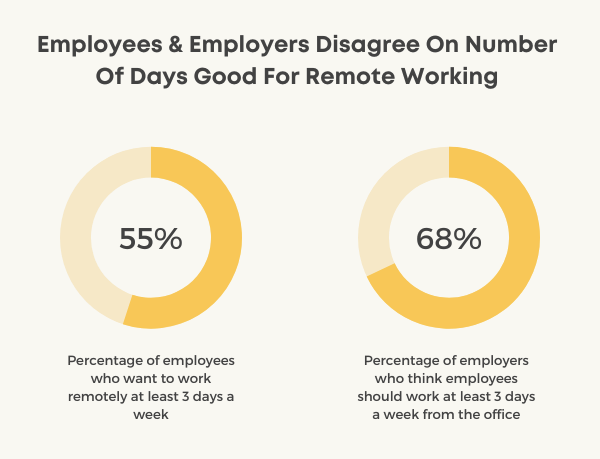Remote work really took off and became a global phenomenon once the COVID-19 pandemic started.
Many businesses had to close their offices and send their employees to work from home, resulting in a monumental shift from on-site to remote work.
So, what has changed since before the pandemic? What will remote work look like after the pandemic? How many employees and employers are in favor of remote work?
Time to find out about all of the most interesting COVID remote work statistics!
Editor’s Pick Of Remote Work Statistics Before And After COVID
- Before the pandemic, only 20% of Americans worked from home.
- 54% of executives report an increase in employee productivity.
- 88% of companies worldwide encouraged employees to work from home.
- 50% of workers won’t return to jobs that don’t offer flexible hours.
COVID Remote Work Statistics: Before The Pandemic
1. Before the pandemic, only 1 in 5 American workers teleworked all or most of the time.
While many American workers agree their jobs could have been done from home even before the pandemic, most of them rarely or never worked from home. On the other side, 20% reported they worked from home all or most of the time, pre-pandemic.
Source: Pew Research Center
2. Prior to the COVID-19 pandemic, out of those who worked from home, 41.5% had advanced education.
Out of those who worked from home in 2019, almost half had advanced education. Another 33.9% had a bachelor’s degree only. That means that more than 7 in 10 of those who worked from home had at least a bachelor’s degree or more. On the other hand, those with lower education made up for less of the percentage of those who worked from home.
Source: US Bureau of Labor Statistics
Pandemic Remote Work Statistics: During The COVID-19 Pandemic
3. During the pandemic, 71% of American workers telecommuted full-time or most of the time.
While only 20% of American workers did work from home before the COVID-19 outbreak, once the pandemic started the number went up by more than triple. During the global pandemic, more than 7 in 10 telecommuted, i.e. they worked from home.
Source: Pew Research Center
4. While the shift from on-site to remote work has been easy for many, younger workers and parents are more like to have struggled with the transition.
To be able to work from home, workers need access to technology and equipment. For instance, 56% of those surveyed in a study by Pew Research Center, responded that it was easy for them to access the technology and equipment needed to get their work done. On the other hand, 32% say that it was somewhat or very difficult to get work done without interruptions, especially those who are parents or younger than 50.
Source: Pew Research Center
5. The majority of workers from home use online video conferencing or video calling, and online chat platforms to stay in touch with their colleagues during the pandemic.
The advancement of technology has helped a lot with keeping in touch with people anywhere in the world. Moreover, 81% of those working from their homes report they use platforms like Zoom to keep in touch, with 59% of them saying they use those video services often. Likewise, 57% say they use online chat platforms like Slack to stay in touch.
Source: Pew Research Center
6. 54% of executives say that the average employee productivity has improved while working remotely during the pandemic.
This COVID remote work statistics is the one most talked about. According to research, many executives and employees report that they have been working more than ever before once they exchanged the office for their homes. This could be due to fewer distractions, compared to distractions in the workplace.
Source: PwC


7. After the pandemic started, 88% of the world’s companies encouraged or ordered their employees to work from home.
Almost 9 in 10 companies worldwide made it mandatory for their employees to work from home, or at least encouraged them to do so once the pandemic started. According to the same Gartner study, 97% of companies also quit all types of business travel once the pandemic was announced.
Source: Gartner
8. 83% of companies say that the transition to remote work has been successful for their business.
According to a PwC study from 2021, 83% of companies found shifting to remote work a success. This shows a rise from the year before, as well, as 73% of companies stated they found the shift successful in 2020.
Source: PwC
Remote Work Statistics: After COVID-19
9. Less than 1 in 5 executives want to return to the office as it was pre-pandemic.
While most of them do not want to let go of the office for good, 13% are ready to do so. On the other hand, 87% think that the office is important for their business in terms of collaboration and building relationships. However, they are still deciding how to extend remote work and incorporate it along with office days.
Source: PwC
10. While 68% of employers expect employees to work in the office at least three days a week, 55% of employees would prefer to work remotely at least three days a week.
It seems like employees and employers will have a hard time finding a consensus on how many days a week should be spent working from home and in the office once the pandemic is done.
Source: PwC


11. 54% of those whose jobs can be done from home want to stay working from home even once the pandemic is over.
If they were offered a choice to stay working remotely, 54% of those whose jobs can be done from home (fully or for the most part) would like to continue working from home even once the pandemic is over. When it comes to gender, 56% of those in favor are women.
Source: Pew Research Center
12. 50% of workers say they will not return to jobs that don’t offer flexible hours once the pandemic is over.
One in two of those who have been working from home full-time for 6 months or longer during the pandemic don’t want to go back to the office. On the contrary, they want their jobs to offer them flexible hours so they can continue working remotely even after the pandemic. Otherwise, they will quit, according to COVID remote work statistics data from Owl Labs.
Source: Owl Labs
13. As a result of the pandemic, 61.9% of companies are planning more remote work options.
In the next few years, more than 6 in 10 companies say they will plan more remote work options, according to remote hiring statistics. This comes as no surprise, as remote work is proving to be a success and flexibility is something employees want from their employers and jobs.
Source: Upwork
14. 74% of companies are going to shift some of their employees to work remotely permanently.
Having remote workers on teams is something that will become a norm in the future, 85% of managers believe, according to TECLA data. Moreover, over 7 in 10 companies will allow some of their workers to permanently work from home in the future.
Source: Gartner
15. After the pandemic, 25 to 30% of American workers will be working remotely one or more days per week.
This is a very promising forecast from Global Workplace Analytics. According to their stats, around one-quarter of all the American workers will be working from home at least one day a week, if not more.
Source: Global Workplace Analytics
16. Around 30% of workers are expecting to work permanently even after the pandemic.
According to Statista, around 70% of workers worked remotely in March 2021. And just below half of them, 31% are expecting to work from home even after the pandemic.
Source: Statista
Conclusion
To sum up, we can tell that the pandemic made remote work flourish. In the upcoming years, remote work could reach its full potential. These remote work statistics before and after COVID do tell us how productivity has increased, and how employees learned to love this type of work. A more extensive list of remote work statistics can tell us even more about this global phenomenon that took over the world thanks to the pandemic.


































Find Us on Socials